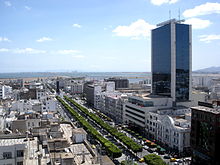Avenue Habib Bourguiba
 |
|
 |
|
| Width | 60 m |
|---|---|
| Location | Tunis, Tunisia |
| Coordinates | 36°48′00″N 10°11′07″E / 36.800054°N 10.185184°E |
| East end | Lake of Tunis |
| West end | Place de l'Indépendance (and Avenue de France extension) |
Avenue Habib Bourguiba (Tunisian Arabic: شارع حبيب بورڨيبة) is the central thoroughfare of Tunis, and the historical political and economic heart of Tunisia. It bears the name of the first President of the Republic of Tunisia and the national leader of the Tunisian independence movement. Today, the broad Avenue aligned in an east-west direction, lined with trees and facades of shops, and fronted with street cafes on both sides, and which is compared to the Champs-Élysées in Paris, and its extension, the Avenue de France, Place de l'Indépendance marking the central roundabout with Lake of Tunis at the eastern end. Many of the important monuments are located along this avenue, including Cathedral of St. Vincent de Paul, French Embassy in Tunisia and Théâtre municipal de Tunis.
Most cities in Tunisia have an Avenue Habib Bourguiba.
The road was originally known as the "Promenade de la Marine", a poor quality road which grew muddy in winter and dusty in summer. Within thirty years after the introduction of the French protectorate of Tunisia, the town grew up to the east of the Medina. The Consulate of France, became the seat of the French residence and built in 1890–1892. The avenue became the entertainment centre of the city too, and the playground for the city's elite. In 1920 the Municipal Theatre was built. In addition, the Cathédrale Saint-Vincent-de-Paul de Tunis was completed in 1897. On the eve of the First World War, the new major street in the centre was renamed Avenue Jules-Ferry after Jules Ferry.
During the protests of 2011, many demonstrations calling for the downfall of President Zine el-Abidine Ben Ali and that of the national unity government were held on the avenue.
Sixty meters wide, it has two unpaved roads on both sides of a median strip planted with, until 2001, a quadruple range of ficus trees (reduced to two rows in a major 2000–2001 renovation). Important private buildings such as The Coliseum (galleries, cafes and movie theatres) in 1931 and the Hotel Claridge in 1932 came to be built. At the advent of independence in 1956, the statue was toppled and the avenue was renamed after the new president Habib Bourguiba. New private buildings emerged from extensive investments, such as international hotels.
...
Wikipedia
